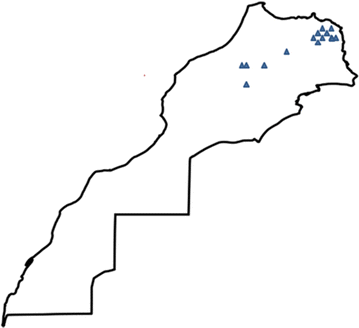High frequency of the recurrent c.1310_1313delAAGA BRCA2 mutation in the North-East of Morocco and implication for hereditary breast-ovarian cancer prevention and control
- PMID: 28577564
- PMCID: PMC5457611
- DOI: 10.1186/s13104-017-2511-2
High frequency of the recurrent c.1310_1313delAAGA BRCA2 mutation in the North-East of Morocco and implication for hereditary breast-ovarian cancer prevention and control
Abstract
Background: To date, a limited number of BRCA1/2 germline mutations have been reported in hereditary breast and/or ovarian cancer in the Moroccan population. Less than 20 different mutations of these two genes have been identified in Moroccan patients, and recently we reported a further BRCA2 mutation (c.1310_1313delAAGA; p.Lys437IlefsX22) in three unrelated patients, all from the North-East of the country. We aimed in this study to evaluate the frequency and geographic distribution of this BRCA2 frameshift mutation, in order to access its use as the first-line BRCA genetic testing strategy for Moroccan patients. We enrolled in this study 122 patients from different regions of Morocco, with suggestive inherited predisposition to breast and ovarian cancers. All subjects gave written informed consent to BRCA1/2 genetic testing. According to available resources of our lab and enrolled families, 51 patients were analyzed by the conventional individual exon-by-exon Sanger sequencing, 23 patients were able to benefit from a BRCA next generation sequencing and a target screening for exon 10 of BRCA2 gene was performed in 48 patients.
Results: Overall, and among the 122 patients analyzed for at least the exon 10 of the BRCA2 gene, the c.1310_1313delAAGA frameshift mutation was found in 14 patients. Genealogic investigation revealed that all carriers of this mutation shared the same geographic origin and were descendants of the North-East of Morocco.
Discussion: In this study, we highlighted that c.1310_1313delAAGA mutation of BRCA2 gene is recurrent with high frequency in patients from the North-East region of Morocco. Therefore, we propose to use, in public health strategies, the detection of this mutation as the first-line screening tests in patients with breast and ovarian cancer originated from this region.
Keywords: BRCA2; Breast cancer; North-East Morocco; Recurrent mutation.
Figures
Similar articles
-
Increased prevalence of the founder BRCA1 c.5309G>T and recurrent BRCA2 c.1310_1313delAAGA mutations in breast cancer families from Northerstern region of Morocco: evidence of geographical specificity and high relevance for genetic counseling.BMC Cancer. 2023 Apr 13;23(1):339. doi: 10.1186/s12885-023-10822-5. BMC Cancer. 2023. PMID: 37055759 Free PMC article.
-
Mutational spectrum of BRCA1/2 genes in Moroccan patients with hereditary breast and/or ovarian cancer, and review of BRCA mutations in the MENA region.Breast Cancer Res Treat. 2022 Jul;194(1):187-198. doi: 10.1007/s10549-022-06622-3. Epub 2022 May 17. Breast Cancer Res Treat. 2022. PMID: 35578052
-
Tracking of the origin of recurrent mutations of the BRCA1 and BRCA2 genes in the North-East of Italy and improved mutation analysis strategy.BMC Med Genet. 2016 Feb 6;17:11. doi: 10.1186/s12881-016-0274-6. BMC Med Genet. 2016. PMID: 26852130 Free PMC article.
-
Prevalence of specific and recurrent/founder pathogenic variants in BRCA genes in breast and ovarian cancer in North Africa.BMC Cancer. 2022 Feb 25;22(1):208. doi: 10.1186/s12885-022-09181-4. BMC Cancer. 2022. PMID: 35216584 Free PMC article.
-
Twenty Years of BRCA1 and BRCA2 Molecular Analysis at MMCI - Current Developments for the Classification of Variants.Klin Onkol. 2019 Summer;32(Supplementum2):51-71. doi: 10.14735/amko2019S51. Klin Onkol. 2019. PMID: 31409081 Review. English.
Cited by
-
Identification of BRCA2 Cis Double Heterozygous Breast Cancer Cases Using Whole Exome Sequencing: Phenotypic Expression and Impact on Personalized Oncology.Front Genet. 2021 Aug 12;12:674990. doi: 10.3389/fgene.2021.674990. eCollection 2021. Front Genet. 2021. PMID: 34456966 Free PMC article.
-
Prevalence of Clinically Relevant Germline BRCA Variants in a Large Unselected South African Breast and Ovarian Cancer Cohort: A Public Sector Experience.Front Genet. 2022 Apr 8;13:834265. doi: 10.3389/fgene.2022.834265. eCollection 2022. Front Genet. 2022. PMID: 35464868 Free PMC article.
-
Identification of a novel pathogenic variant in PALB2 and BARD1 genes by a multigene sequencing panel in triple negative breast cancer in Morocco.J Genomics. 2021 Sep 18;9:43-54. doi: 10.7150/jgen.61713. eCollection 2021. J Genomics. 2021. PMID: 34646395 Free PMC article.
-
Prevalence of BRCA mutations among hereditary breast and/or ovarian cancer patients in Arab countries: systematic review and meta-analysis.BMC Cancer. 2019 Mar 21;19(1):256. doi: 10.1186/s12885-019-5463-1. BMC Cancer. 2019. PMID: 30898109 Free PMC article.
-
The Cds.71 on TMS5 May Act as a Mutation Hotspot to Originate a TGMS Trait in Indica Rice Cultivars.Front Plant Sci. 2020 Aug 7;11:1189. doi: 10.3389/fpls.2020.01189. eCollection 2020. Front Plant Sci. 2020. PMID: 32849737 Free PMC article.
References
-
- Willems PG. Susceptibility genes in breast cancer: more is less? Clin Genet. 2007;72:493–496. doi: 10.1111/j.1399-0004.2007.00909.x. - DOI
MeSH terms
Substances
Supplementary concepts
LinkOut - more resources
Full Text Sources
Other Literature Sources
Medical
Miscellaneous


